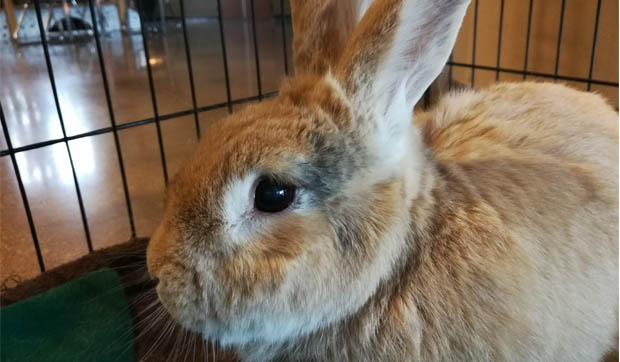He’s awfully cute, but Hickory Knolls’ Peter Rabbit is also a lot of work. This year he’s helping spread the word about Make Mine Chocolate, an effort aimed at reducing the number of bunnies who end up in shelters and rescues following the Easter holiday.
Good Natured: Make Mine Chocolate
April 5, 2019
There are a few things in this world that I’m absolutely nuts about. Snakes are one, puppies are another. And then there’s chocolate.
As I write this, I’ve made an embarrassing number of attempts to scrounge for anything resembling chocolaty goodness. Worse, I’ve come up distressingly short. A packet of hot cocoa mix left over from a long-ago night hike. A lone chocolate chip, hidden for who knows how long behind a bottle of vanilla extract. And the freshest of the lot, a Reese’s peanut butter Christmas tree. Sure, Christmas was a few months ago, but still within memory. Which is more than I can say for the last time I bought chocolate chips.
So I guess it’s only fitting that this week’s column focus on a pro-chocolate effort I’m proud to endorse: The Make Mine Chocolate Campaign. This Columbus,OH based organization aims to reduce the number of homeless bunnies-furry, not chocolate–that pop up in the weeks and months following Easter.
That’s right, homeless bunnies. Who knew? But sadly, it seems there are still plenty of folks out there who believe that live bunnies make good Easter gifts. After all, how much trouble could a little bun be?
As it turns out, plenty. They’re messy. They can bite. They can spray. And if kept in multiples, they can reproduce like, well, rabbits.
Thankfully, Make Mine Chocolate has assembled an impressive array of posters, videos and other materials that lay out the honest truths about rabbits and their habits. The facts include:
- Rabbits are not like dogs and cats. They are prey animals who can be easily frightened by loud noise and quick, unpredictable human movements. Rabbits are the third largest group of animals relinquished to shelters and rescues.
- Rabbits require routine veterinary care, and should be spayed or neutered to prevent behavior problems. Unaltered animals are more likely to display aggression and destructive inclinations, and can be more difficult to litterbox train.
- Releasing an unwanted rabbit outdoors, also known as giving the animal its freedom, rarely ends well. The rabbit can be killed by a predator or hit by a vehicle; it also may succumb to harsh weather conditions, disease or parasites. (In my experience, domestic animals let loose among wild populations also can transmit illnesses of their own. Not good for wildlife communities of any sort.)
Now if you’ve ever visited Hickory Knolls, and met our own Peter Rabbit, you’ll know that we were not daunted by these stark statements. In fact, we suspect that Petey met at least some of those criteria. He was picked up as a stray in DuPage County in 2008, and after going unclaimed at Animal Control was transferred to Fur Angels Animal Sanctuary in Aurora where he received veterinary care, including neutering.
Over the past decade, Peter has gained a following of folks throughout the region. He’s adorable, for sure, but we’ve worked hard to use that cuteness as a gateway to rabbit ownership education. We make sure visitors contemplating the purchase of a pet bun know that there’s a lot more to its care than just food, water and the occasional scratch behind the ears. Here’s a sampling of the sorts of information we share:
- Domestic rabbit breeds were developed from a European species, Oryctolagus cuniculus. Eastern cottontails, the wild rabbit species in our area, are classified as Sylvilagus floridanus.
- Domestic rabbits are best suited to living indoors, not out.
- Bunnies chew on anything and everything, including baseboards, furniture legs and electrical cords.
- Rabbit fur is fine and super soft, which is nice. But it sheds continuously, which is not.
- Litterboxes fill up and need to be cleaned, at least once a day and sometimes more.
- Rabbits have strict dietary needs, and a bowl of pellets doesn’t come close to meeting them. Timothy hay is an important component as are fresh greens and smidge of fruit.
- Exercise is a must.
- There’s no such thing as a “dumb bunny.” Petey outsmarts us, or at least me, on an almost daily basis.
I don’t want to come across as a high-and-mighty, no-one-is-good-enough-to-own-a-rabbit advocate. There are thousands of people who make great rabbit owners. And that’s a good thing, because there are thousands of rabbits that need homes.
But if you or someone you know is considering the purchase of living, breathing Easter rabbit, think twice about caving in. Remember, that the little furball will still be with you 10 years down the road. If a decade of committed pet care isn’t your thing, you might want to make yours chocolate.
Pam Otto is the manager of nature programs and interpretive services at the Hickory Knolls Discovery Center, a facility of the St. Charles Park District. She can be reached at 630-513-4346 or potto@stcparks.org.

